The Grand Wilcockson Tour to Derbyshire Day 1: Puritan William Wilcockson and Biggin-by-Hulland
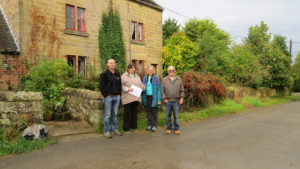
Copyright © Jane E. Wilcox, Forget-Me-Not Ancestry, Albany, NY www.4getmenotancestry.com.
In September 2017 I led a tour to Derbyshire, England, in search of my Puritan ancestors William Wilcockson and his wife Margaret. They came to New England on the Planter in 1635 with their two-year-old son John Wilcockson and Ann Harvie, whom I believe to be Margaret’s sister. They came during the Puritan Great Migration 1620-1640. With them on the Planter were Margaret’s first cousins Richard Harvie and his sister Mary Harvie with her husband William Beardsley and their three children Mary, John and infant Joseph. This homecoming trip with my cousins in 2017 culminated my research on the Wilcocksons of Biggin-by-Hulland, the Harvies of Ilkeston and their minister Rev. Adam Blakeman/Blackman (who founded Stratford, Conn. with them in 1639) that I undertook on three genealogy research trips to England between 2000 and 2015.
On this trip my cousins and I followed in the footsteps of Puritan William and Margaret Wilcockson (not spelled Wilcoxson as many have tried to modernize it) from their origins in Derbyshire, England, to their exposure to non-conformist ideas that eventually caused them to emigrate to America, to the churches they attended, to their dissenting Puritan network of family and friends, to their journey to the port of London to take passage on the Planter in 1635. While in England I sent daily emails to about 50 of my extended family and friends, as I had done in the past with the three other research trips, sharing our journey with them. The emails sent during the trip have been expanded and fact-checked to present here as blog posts. When you are reading my account of Puritan William in England, keep in mind that this is a proposed family of origin for William Wilcockson of Stratford, Conn. based on the evidence in the available records. Think “probable” and “probably” when you read Puritan William’s story.
Down the road I will write a series of articles giving the documentary evidence as to why I believe Puritan William was the son of tanner William Wilcockson and his first unknown wife from Biggin-by-Hulland, Derbyshire, and why Puritan William’s wife Margaret was Margaret Harvie, daughter of weaver James Harvie and his wife Elizabeth Winfield from Ilkeston Derbyshire — and not Margaret Birdseye or Birdsey as has long been erroneously held. These articles will contain more details and all of the sources I used to compile the evidence, as well as the genealogies of the Wilcockson, the Harvie and the Blakeman families in England in the 1500s and early 1600s.
Now for the story of our trip…
Day 1
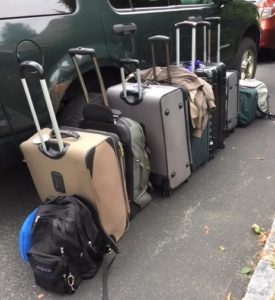
We arrived safely at Heathrow on 21 September 2017 after departing JFK the evening before at 8:00pm. We had gathered the day before at my cousin Chet’s home on Long Island and were shuttled to the airport. My cousin Jim’s wife Pat and his son Barry had flown in from Tampa. Pat’s sister Marilyn had driven from Maine and I had driven from Albany. The adventure began with the five of us!
It was an exhausting and almost sleepless 24 hours since our departure from Chet’s!
The usual glitches greeted us in London. The smartphone I bought two years ago (only $100US with all the bells and whistles a U.S. Droid has, BTW) for GPS directions and communication with my researcher-colleagues in England was locked and I hadn’t written down all my security codes and numbers to unlock it. We needed the phone for Google Maps and communication again, so I ended up buying a new smartphone for this trip — one that isn’t locked!
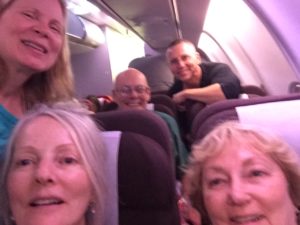
Jane, Marilyn, Chet, Barry and Pat getting ready to depart JFK for the trip of a lifetime.
Then we had a change in plans with the car rentals. Instead of two smaller cars we ended up in one Mercedes SUV with Sat Nav. So much for the smart phone — or so I thought to start. Google Maps on the smartphone came in very handy as we traveled north to Derbyshire where we were heading to pick up the Wilcockson story from the 1500s and 1600s. Barry took the reins with the car to start as I wasn’t too comfortable driving such a large car with sleep deprivation from two consecutive nights. It was his first driving experience in England and he did wonderfully!
We had a 3:00pm appointment with local historian Wendy Whitbread of Biggin-by-Hulland. I had met Wendy 2-1/2 years ago on my last research trip to England when I drove to Biggin-by-Hulland and stopped a man in his field to ask a question. He said I should ask his sister who was writing a history of Biggin. His sister was Wendy, and Wendy knew of the Wilcocksons.
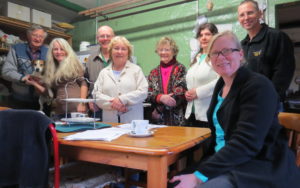
Bill, Indie the dog, Marilyn, Chet, Pat, Maureen, Wendy, Jane and Barry.
On this trip Wendy and her parents, Bill and Maureen, invited us in for some wonderful Yorkshire tea. We chatted about their 17th century house, admired all the tea cups they had collected, and looked at maps of Biggin that I had brought. Wendy then showed us around what was known as Nether Biggin as we walked the roads where I believe our Wilcockson ancestors lived. “Nether” means lower. A cluster of perhaps six to eight houses makes up Nether Biggin today.
Here’s the long Wilcockson story in short: Through exhaustive research by me and three professional genealogists/historical researchers in Derbyshire and London whom I had engaged periodically since 2002 when I first went to England for the Wilcockson research (Peter Foden, Simon Neal, and, with a special thank you, Celia Renshaw), as well as a read of a very early draft of my research findings by Robert C. Anderson, the Puritan Great Migration expert at the New England Historic Genealogical Society in Boston, and using Y-DNA evidence, I’ve come to the conclusion that my Puritan William Wilcockson was probably the son of a tanner, William Wilcockson, of the manor of Biggin. Biggin was a submanor in the manor of Duffield Fee in Derbyshire, and Duffield Fee in turn was part of the Duchy of Lancaster. When the Lancastrians became kings of England with Henry IV in 1399, so too the manor of Biggin became a royal manor at that time.
Tanner William Wilcockson, born ca. 1553 and died in 1626, was the son of Thomas Wilcockson, perhaps born ca. 1520 and who died ca. 1601. We find this relationship between father and son in several records from 1581 and 1612. Tanner William had two living sons named William when he wrote his will in 1626: his eldest son William and his younger son William — one from each of his two wives.
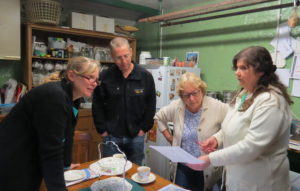 Now for Puritan William’s connection. (Don’t forget to add the words “probable” and “probably” to the rest of this story as there is no evidence that directly links Puritan William to his proposed father, tanner William. It’s connecting the dots through circumstantial/indirect evidence to form what is called a proof argument.) I believe that Puritan William was tanner William’s eldest son William, named as such in the 1626 will. Puritan William was the son of tanner William’s first unknown wife, who I think may have died in childbirth with Puritan William ca. 1600. (The Planter passenger list from April 1635 suggests that Puritan William at age 34 was born 1600-1602.)
Now for Puritan William’s connection. (Don’t forget to add the words “probable” and “probably” to the rest of this story as there is no evidence that directly links Puritan William to his proposed father, tanner William. It’s connecting the dots through circumstantial/indirect evidence to form what is called a proof argument.) I believe that Puritan William was tanner William’s eldest son William, named as such in the 1626 will. Puritan William was the son of tanner William’s first unknown wife, who I think may have died in childbirth with Puritan William ca. 1600. (The Planter passenger list from April 1635 suggests that Puritan William at age 34 was born 1600-1602.)
After the death of his first wife, tanner William married a second time, to a much younger (by about 25 years) woman named Winifred Ollerenshaw, the daughter of Peter Ollerenshaw, a Puritan minister whose church was in Shepshed, Leicestershire. Winifred’s first born son with tanner William — named Peter Wilcockson for his maternal grandfather — was the one who inherited tanner William’s tannery in Biggin when tanner William died in 1626. This left our Puritan William out of his primogeniture inheritance as the eldest son. I think Winifred may have had a prenup with tanner William that specified that her eldest son with him (and not the eldest from tanner William’s first marriage) would inherit tanner William’s tannery and property. (More on English manorial land-holding system tomorrow.)
What happened to my Puritan William? He was sent off to learn weaving, perhaps with members of his mother’s family — uncles or a grandfather — or perhaps with Wilcockson kin who were weavers. The passenger list for the Planter tells us that Puritan William was a linen weaver.
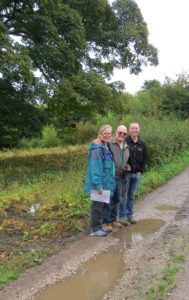
The tan yard of Puritan William Wilcocksons father, William Wilcockson.
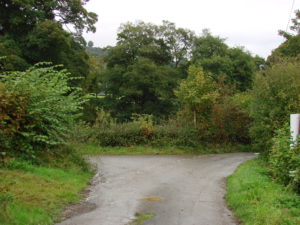
The Wilcockson tan yard in Nether Biggin, at the fork in the road. Photo by Chet Wilcox.
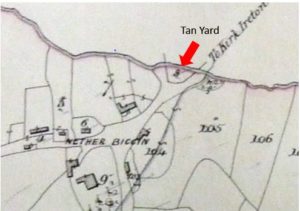
Portion of 1841 Tithe Map of Biggin showing the Wilcockson tan yard in Nether Biggin.
So that brings us to Nether Biggin and the tannery. An 1841 tithe map of Biggin shows a “tan yard” and names all the parcels of land that made up Biggin. The parcels had names like Ruddings a.k.a. Riddings, le Netherfeild [sic], Towne Feild, and Kill Croft — names that show up in the Duffield Fee manorial court records where we find tanner William from the submanor of Biggin in the 1500s and 1600s. See the tithe map on the left.
The tan yard is still in Nether Biggin. It is an open space with a huge tree. Seeing the tan yard was probably the highlight of the day — a concrete location for tanner William and his son, our Puritan William. In the photo above, Chet, Barry and I are standing in front of the tan yard as it is seen today. See the photo below of the house that is standing where tanner William’s house probably stood some 500 years ago. The Ecclesbourne River runs at the back of this property and at the back of the tan yard. Biggin is in the Ecclesborne Valley and is in an out-of-the-way place. There are no roads that pass through Biggin; the one-lane road goes to Nether Biggin and stops.
The Wilcocksons first appeared by name in Biggin in 1440 in the Duchy of Lancaster manorial court records. A John Wilcokson of Biggin was present at the court and appointed hayward (hedge/fence warden) for Biggin and a William Wilkocson of Biggin was present and fined for breaking the ale brewing laws. Prior to that a survey of Biggin land and landholders (called Coucher’s survey) had been taken in 1415, but there were no Wilcockson families in Biggin at that time. Hereditary surnames (meaning they were consistently passed from father to the next generations) were just taking hold in the north and west of England then — the practice having spread from London and the south and west, so it’s possible that the Wilcockson forefathers were going by another name when Coucher’s survey was taken.
The name Willeson (Wilson) was in the Biggin survey in 1415. It’s possible that a Willeson was known as Little Will and he had a son who took on the surname Wilcockson. The meaning of the Wilcockson surname is Little Will’s son: Wil = William; cock = used as a diminuative, like little or small; and son = son (son comes from Scandinavian patronymic influences in England, by the way). It’s also possible that the Wilcocksons arrived in Biggin between 1415 and 1440 from the northeast where the Wilcockson surname is first found in the 1330s in Cumberland County and in the 1370s in Yorkshire in subsidy (tax) records.
The rest of the Wilcockson story will unfold as we undertake our Grand Wilcockson Tour in the next few days.
We’re staying at a converted barn in Shottle, only 10 miles from Biggin. We’re in the heart of Wilcockson country! Spout Barn is a holiday house with a kitchen, sitting room, three bedrooms and other amenities. We went to the grocery store (Morrison’s) to buy food for breakfasts and then had our first fish and chips of the trip for dinner. I insisted everyone try them the English way — with salt and vinegar on both the fish and chips. I also insisted that everyone try the mushy peas – which are exactly what you are thinking. Mushy. These peas were particularly good.
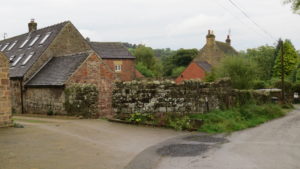
18th century house standing on the spot where tanner William’s house probably stood.
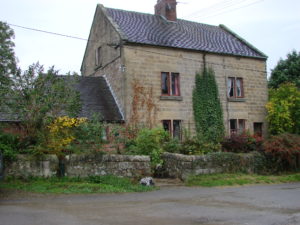
Photo by Chet Wilcox.

Photo by Chet Wilcox.
Cheers!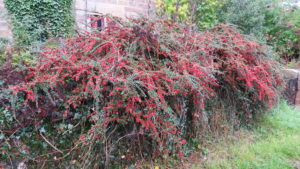
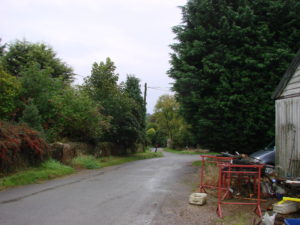
To the left is the Wilcockson property from the 1500s and early 1600s in Nether Biggin. Photo by Chet Wilcox.

10 thoughts on “The Grand Wilcockson Tour to Derbyshire Day 1: Puritan William Wilcockson and Biggin-by-Hulland”